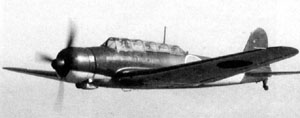Nakajima B5N
|
|
| Nakajima B5N2 | ||
|---|---|---|

| ||
| Description | ||
| Role | Torpedo bomber | |
| Crew | 3 | |
| First Flight | January 1937 (B5N1) | |
| Entered Service | 1937 | |
| Manufacturers | Nakajima, Aichi, Dai-Juichi | |
| Dimensions | ||
| Length | 10.30 m | 33' 10" |
| Wingspan | 15.52 m | 50' 11" |
| Height | 3.70 m | 12' 2" |
| Wing area | 37.7 m² | 406 ft² |
| Weights | ||
| Empty | 2,279 kg | 5,024 lb |
| Loaded | 3,800 kg | 8,380 lb |
| Maximum takeoff | 4,100 kg | 9,040 lb |
| Powerplant | ||
| Engines | 1x Nakajima Sakae 11 | |
| Power | 750 kW | 1,000 hp |
| Performance | ||
| Maximum speed | 367 km/h | 229 mph |
| Range | 1,935 km | 1,202 miles |
| Service ceiling | 8,260 m | 27,100 ft |
| Rate of climb | 391 m/min | 1,283 ft/min |
| Wing loading | 101 kg/m² | 21 lb/ft² |
| Power/Mass | 0.20 kW/kg | 0.12 hp/lb |
| Avionics | ||
| Armament | ||
| Guns |
1x 7.7 mm Type 92 machine gun tail gun | |
| Stores |
1x 800 kg (1,760 lb) torpedo or | |
The Nakajima B5N (Japanese: 中島 B5N, Allied reporting name: Kate) was the Imperial Japanese Navy's standard torpedo bomber for the first years of World War II. Although, like its Allied counterparts the TBD Devastator and Fairey Swordfish, the type was obsolescent by 1939, B5Ns were flown nearly throughout the whole war. Although primarily used as a carrier-based aircraft, it was also used as a land-based bomber on occasions.
The B5N was designed by a team led by Katsuji Nakamura in response to a 1935 specification by the Navy for a torpedo bomber to replace the Yokosuka B4Y. Internally designated Type K by Nakajima, it successfully competed with the Mitsubishi B5M for a production contract. The first prototype flew in January 1937 and was ordered into production soon afterwards with the full designation Type 97 Carrier Attack Bomber.
It would not be long until the B5N would see combat, first in the Sino-Japanese War, where combat experience revealed several weaknesses in the original B5N1 production model. These were mainly concerned with the lack of protection that the design offered its crew and fuel tanks. Keen to maintain the high performance of the type, the Navy was reluctant to add weight in the form of armour, and instead looked to obtaining a faster version of the aircraft in the hopes of out-running enemy fighters. The B5N2 was given a much more powerful engine, and various modifications were made to streamline it. Although its performance was only marginally better, and its weaknesses remained untreated, this version replaced the B5N1 in production and service from 1939. It was this version that would be used by the Navy in the attack on Pearl Harbor. Apart from this raid, the greatest successes of the B5N2 were the key roles they played in sinking the US Navy aircraft carriers Yorktown, Lexington, Wasp, and Hornet.
The B5N served as the basis for a follow-on design, the Nakajima B6N, which eventually replaced it in front-line service. Subsequently, the B5N continued to fly in secondary roles, such as training, target towing, and anti-submarine warfare. Some of the aircraft used for this latter purpose were equipped with early radars and magnetic anomaly detectors. B5Ns were also used as bombers during the unsuccessful defence of the Philippines in October 1944.
Altogether, around 1,150 were built, of which not a single complete example exists today. A large part of a B5N2 was recovered from the Kuril Islands by a British private collector in 2003.
| Related content | |
|---|---|
| Related Development | |
| Similar Aircraft | |
| Designation Series | |
| Related Lists | List of military aircraft of Japan - List of torpedo bombers |
|
Lists of Aircraft | Aircraft manufacturers | Aircraft engines | Aircraft engine manufacturers Airports | Airlines | Air forces | Aircraft weapons | Missiles | Timeline of aviation |
